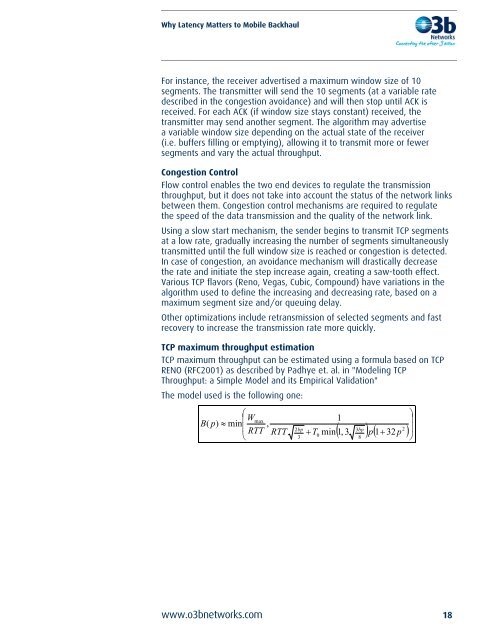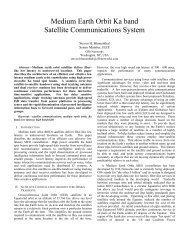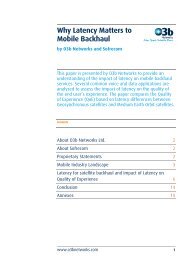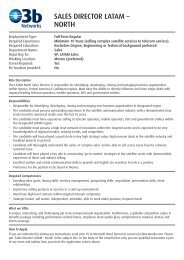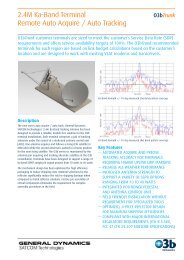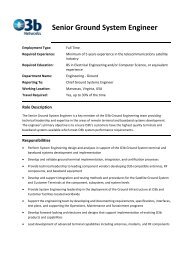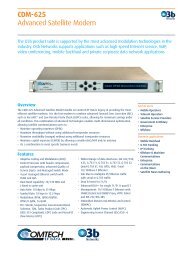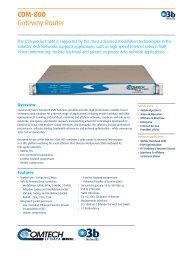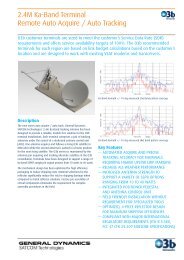Why Latency Matters to Mobile Backhaul - O3b Networks
Why Latency Matters to Mobile Backhaul - O3b Networks
Why Latency Matters to Mobile Backhaul - O3b Networks
You also want an ePaper? Increase the reach of your titles
YUMPU automatically turns print PDFs into web optimized ePapers that Google loves.
<strong>Why</strong> <strong>Latency</strong> <strong>Matters</strong> <strong>to</strong> <strong>Mobile</strong> <strong>Backhaul</strong><br />
For instance, the receiver advertised a maximum window size of 10<br />
segments. The transmitter will send the 10 segments (at a variable rate<br />
described in the congestion avoidance) and will then s<strong>to</strong>p until ACK is<br />
received. For each ACK (if window size stays constant) received, the<br />
transmitter may send another segment. The algorithm may advertise<br />
a variable window size depending on the actual state of the receiver<br />
(i.e. buffers filling or emptying), allowing it <strong>to</strong> transmit more or fewer<br />
segments and vary the actual throughput.<br />
Congestion Control<br />
Flow control enables the two end devices <strong>to</strong> regulate the transmission<br />
throughput, but it does not take in<strong>to</strong> account the status of the network links<br />
between them. Congestion control mechanisms are required <strong>to</strong> regulate<br />
the speed of the data transmission and the quality of the network link.<br />
Using a slow start mechanism, the sender begins <strong>to</strong> transmit TCP segments<br />
at a low rate, gradually increasing the number of segments simultaneously<br />
transmitted until the full window size is reached or congestion is detected.<br />
In case of congestion, an avoidance mechanism will drastically decrease<br />
the rate and initiate the step increase again, creating a saw-<strong>to</strong>oth effect.<br />
Various TCP flavors (Reno, Vegas, Cubic, Compound) have variations in the<br />
algorithm used <strong>to</strong> define the increasing and decreasing rate, based on a<br />
maximum segment size and/or queuing delay.<br />
Other optimizations include retransmission of selected segments and fast<br />
recovery <strong>to</strong> increase the transmission rate more quickly.<br />
TCP maximum throughput estimation<br />
TCP maximum throughput can be estimated using a formula based on TCP<br />
RENO (RFC2001) as described by Padhye et. al. in "Modeling TCP<br />
Throughput: a Simple Model and its Empirical Validation"<br />
The model used is the following one:<br />
⎛<br />
⎜Wmax<br />
B(<br />
p)<br />
≈ min ,<br />
⎜ RTT RTT<br />
⎝<br />
2bp<br />
3<br />
+ T min 1,<br />
0<br />
1<br />
( ) ( ) 3 bp<br />
2<br />
3 p 1+<br />
32 p ⎟⎟ 8<br />
⎠<br />
⎞<br />
www.o3bnetworks.com 18


